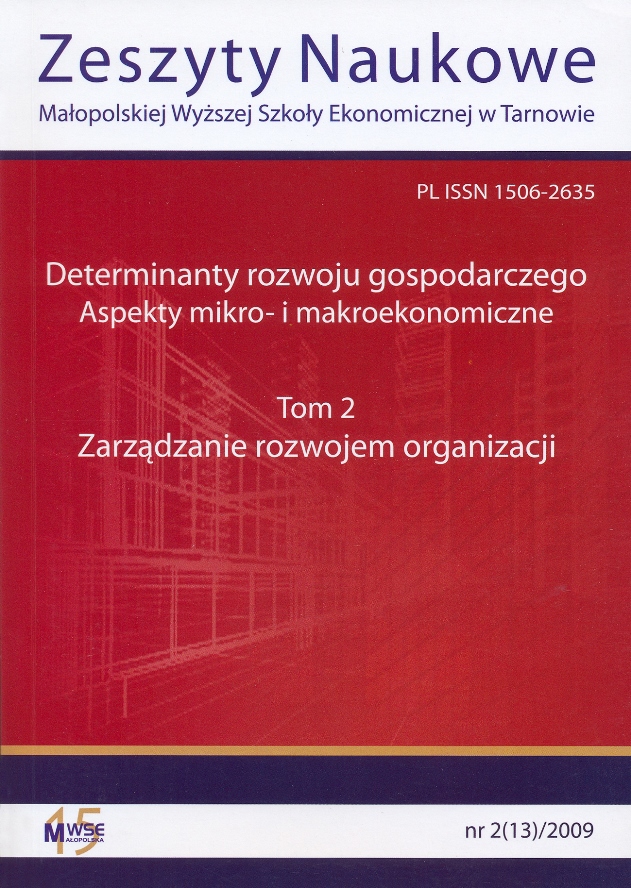Abstract
The author focus on presentation and analysis of main factors having influence on successful and efficient consolidation process. The results introduced in a lecture come from two global reports prepared by the Hay Group in cooperation with La Sorbonne and Mergermarket. The third report shows the studies conducted by Capital Market Area of BZ WBK. The Hay Group has identified two key factors, which provide a firm foundation for a smooth integration process, which companies should adopt to become the part of few successful few. The first one is striking the right balance. Companies should carefully consider how to align and integrate both tangible and intangible assets to be successfully merged, as well as use properly the time between announcement and completion to advance fully both tangible and intangible assets. The second factor is the impact of leadership. We need to acknowledge here, that the roles required in a M&A context are often one or two levels higher than current capacity of senior managers. Top team selection needs to be carried out quickly, as the sooner key roles are defined and allocated, the better level of integration between organizations we can achieve. The top team must also demonstrate the new company values to the workforce in everything they do. The research of Capital Market Area of BZ WBK points out poor preparation of a consolidation process made by Polish companies. In specialists' opinion companies do not analyze potential benefits, which may be achieved in M&A transactions. Most of interviewed managers point out the necessity of better preparation of an integration plan, as well as due diligence analyze in future consolidation processes. The results confirm, that the benefits a successful merger can gain are indisputable. Despite the impact of recent sub-prime lending on the average the availability of credit overall, M&A remains a trusted weapon in the growth strategies of organizations. Customers must pay due attention to a company's real value, which is found in its boardroom, human capital and business culture. When the balance is achieved between tangible and intangible assets, it provides a solid foundation for strategic growth and ensures return on investment.
References
Amit R., Schoemaker P.J. 1993. Strategic Assets and Organizational Rent. "Strategic Management Journal" vol. 14 (January).
View in Google Scholar
Barney J. 1991. Firm Resources and Sustained Competitive Advantage. "Journal of Management" vol. 12.
View in Google Scholar
Collis D.J., Montgomery C.A. 1995. Competing on Resources: Strategy in the 1990s, "Harvard Business Review" vol. 73 (July-August).
View in Google Scholar
Egan J. 2004. Relationship Marketing: Exploring Relational Strategies in Marketing. 2nd ed. Pitman Publishing. ISBN 97-80273-6862-31.
View in Google Scholar
Fasel D. 2000. Partnering in Action: A Guide for Building Successful Collaboration across Organizational Boundaries. Oxford: Pathways. ISBN 185-7036-263.
View in Google Scholar
Ford D., Gadde L.E., Hakansson H., Snehota I. 2003. Managing Business Relationships. 2nd ed. Chichester: John Willey. ISBN 97-80470-8512-58.
View in Google Scholar
Godziszewski B. 2001. Zasobowe uwarunkowania strategii przedsiębiorstwa. Toruń: UMK. ISBN 83-2311-284-3.
View in Google Scholar
Grant R.M. 1991. The Resource - Based Theory of Competitive Advantage: Implications for Strategy Formulation. "California Management Review" vol. 33, iss. 3.
View in Google Scholar
Grant R. 2005. Contemporary Strategy Analysis. 5th ed. Oxford: Blackwell Science. ISBN 78-1405-1199-86.
View in Google Scholar
Halawi L., Aronson J., Mc Carthy R. 2005. Resource-Based View of Knowledge Management for Competitive Advantage. "The Electronic Journal of Knowledge Management" vol. 3, iss. 2.
View in Google Scholar
Petraf M.A. 1997. The Cornerstone of Competitive Advantage. W: Foss N.J (ed.). Resources, Firms, and Strategies: A Reader in the Resource-based Perspective. New York: Oxford University Press. ISBN 01-987-8180-6.
View in Google Scholar
Stankiewicz M.J. 2002. Konkurencyjność przedsiębiorstwa. Budowanie konkurencyjności przedsiębiorstwa w warunkach globalizacji. Toruń: TNOiK. ISBN 83-7285-088-7.
View in Google Scholar
Warren K. 2008. Strategic Management Dynamics. Hoboken: John Wiley. ISBN 978-04-7006-067-4.
View in Google Scholar
© Copyright by Małopolska School of Economics in Tarnów. The articles are available under the Creative Commons Attribution NonCommercial-NoDerivatives 4.0 International License


